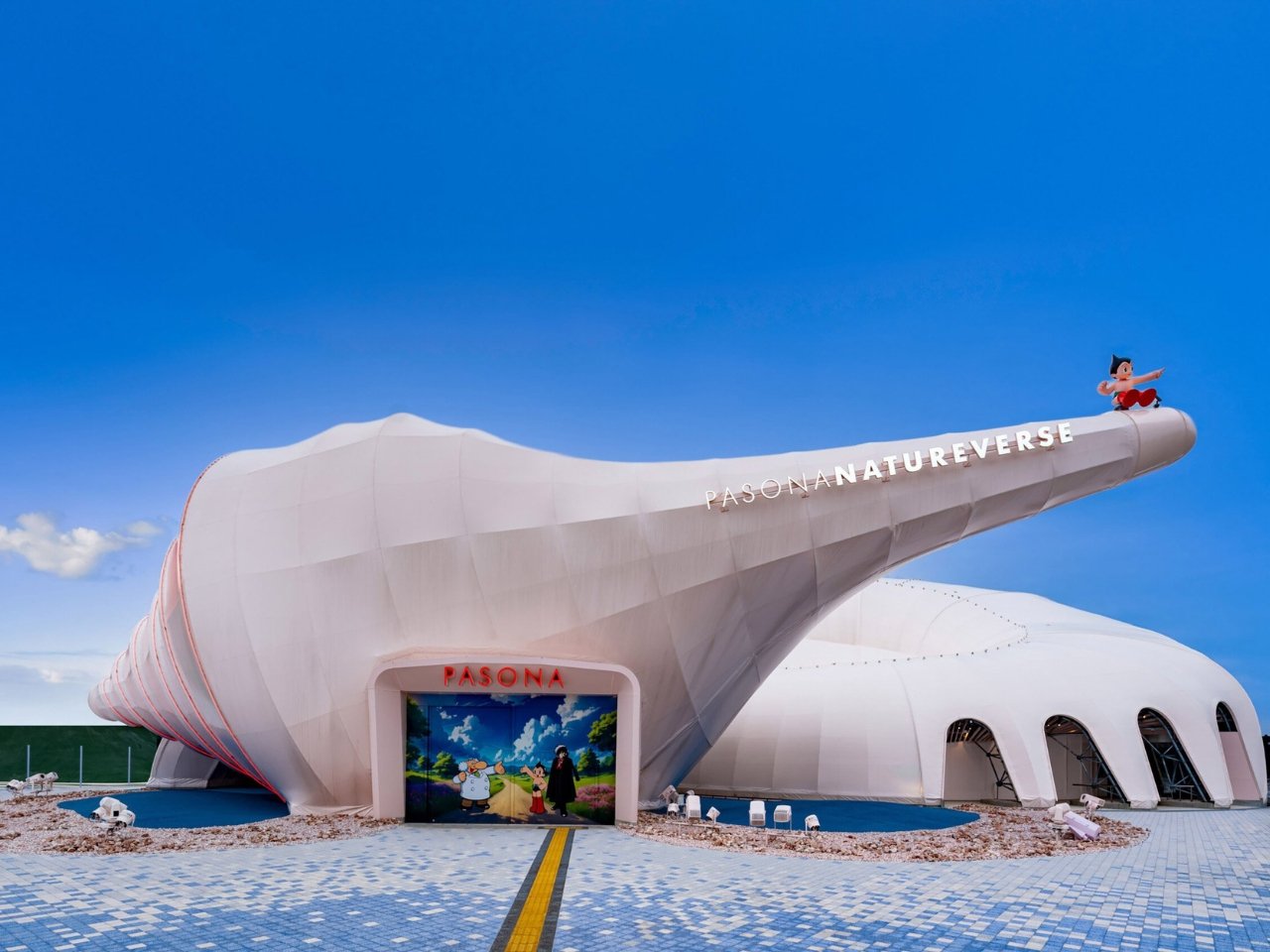Technology
Japan Unveils Stunning Pavilion Inspired by Ancient Marine Life

The Pasona Natureverse Pavilion, a striking architectural marvel inspired by a 400-million-year-old marine mollusc, has debuted at Expo 2025 in Osaka, Japan. Created by the local architecture studio, The Design Labo, this innovative structure resembles a giant ammonite shell and serves as a symbol of life’s continuity, designed specifically for staffing company Pasona Group.
Satoshi Itasaka, CEO of The Design Labo, explained the pavilion’s deeper significance: “Coiled shells have changed little for roughly 400 million years. Having survived repeated mass extinctions without being eliminated, they may represent a ‘completed form’ of life.” This connection to ancient marine life aligns perfectly with the expo’s overarching theme of life, inviting visitors to explore the relationship between humanity and nature.
The pavilion spans an impressive 43 meters in width and features a smaller conch-like structure adorned with a sculpture of the beloved cartoon character NEO Astro Boy. The design does more than offer an aesthetic experience; it tells a story of evolution and resilience through its architecture.
Innovative Features and Sustainability
What sets the Pasona Natureverse Pavilion apart is its harmonious integration with nature. The building employs a sophisticated water-based cooling system, which applies a thin film of water over its surface to minimize reliance on traditional air conditioning. The spiral shape of the pavilion efficiently collects and recycles rainwater, repurposing it as grey water for various functions within the structure.
Inside, the pavilion comprises two shell-shaped areas that offer interactive exhibition spaces focused on physical, mental, and social health. Visitors can journey through three distinct zones—History of Life, Body and Mind/Bonds—each equipped with engaging digital displays. Among the highlights are a tree-shaped sculpture illustrating evolutionary history and a lab-grown heart made from biomaterials.
“It’s a blend of education and surprise,” Itasaka noted, referring to the dynamic exhibits that include moving LED displays and a zone showcasing heart cells derived from induced pluripotent stem (iPS) cells. The combination of art and science creates an enriching environment for all ages.
Future Plans for the Pavilion
Unlike typical temporary exhibition structures, this pavilion is designed for longevity. Utilizing a ball-jointed steel framework covered by a synthetic white membrane, the 43-meter-wide structure is easily demountable. After the expo concludes, it will be relocated to Awaji Island, where it will be transformed into a cultural center, thus granting it a meaningful second life.
As night falls, the pavilion becomes a breathtaking sight, illuminated by color-changing lights along its ridges. These lights enhance the building’s spiral form, making it appear almost alive as it glows softly in the darkness.
This project exemplifies that sustainable design can be both functional and beautiful. “We were reminded that biomimetic forms are not only structurally stable but also inherently beautiful,” Itasaka stated, emphasizing the aesthetic value of sustainability.
The Pasona Natureverse Pavilion transcends conventional architecture, serving as a meditation on time, evolution, and humanity’s role within the natural world. By drawing inspiration from ancient creatures that have thrived for millions of years, the designers have crafted a space that inspires both humility and hope. The pavilion stands as a testament to innovative design that respects the planet and captivates the imagination, showcasing a new paradigm for the future of architecture.
-

 Education3 months ago
Education3 months agoBrandon University’s Failed $5 Million Project Sparks Oversight Review
-

 Science4 months ago
Science4 months agoMicrosoft Confirms U.S. Law Overrules Canadian Data Sovereignty
-

 Lifestyle3 months ago
Lifestyle3 months agoWinnipeg Celebrates Culinary Creativity During Le Burger Week 2025
-

 Health4 months ago
Health4 months agoMontreal’s Groupe Marcelle Leads Canadian Cosmetic Industry Growth
-

 Technology3 months ago
Technology3 months agoDragon Ball: Sparking! Zero Launching on Switch and Switch 2 This November
-

 Science4 months ago
Science4 months agoTech Innovator Amandipp Singh Transforms Hiring for Disabled
-

 Education3 months ago
Education3 months agoRed River College Launches New Programs to Address Industry Needs
-

 Technology4 months ago
Technology4 months agoGoogle Pixel 10 Pro Fold Specs Unveiled Ahead of Launch
-

 Business3 months ago
Business3 months agoRocket Lab Reports Strong Q2 2025 Revenue Growth and Future Plans
-

 Technology2 months ago
Technology2 months agoDiscord Faces Serious Security Breach Affecting Millions
-

 Education3 months ago
Education3 months agoAlberta Teachers’ Strike: Potential Impacts on Students and Families
-

 Science3 months ago
Science3 months agoChina’s Wukong Spacesuit Sets New Standard for AI in Space
-

 Education3 months ago
Education3 months agoNew SĆIȺNEW̱ SṮEȽIṮḴEȽ Elementary Opens in Langford for 2025/2026 Year
-

 Technology4 months ago
Technology4 months agoWorld of Warcraft Players Buzz Over 19-Quest Bee Challenge
-

 Business4 months ago
Business4 months agoNew Estimates Reveal ChatGPT-5 Energy Use Could Soar
-

 Business3 months ago
Business3 months agoDawson City Residents Rally Around Buy Canadian Movement
-

 Technology2 months ago
Technology2 months agoHuawei MatePad 12X Redefines Tablet Experience for Professionals
-

 Business3 months ago
Business3 months agoBNA Brewing to Open New Bowling Alley in Downtown Penticton
-

 Technology4 months ago
Technology4 months agoFuture Entertainment Launches DDoD with Gameplay Trailer Showcase
-

 Technology4 months ago
Technology4 months agoGlobal Launch of Ragnarok M: Classic Set for September 3, 2025
-

 Technology4 months ago
Technology4 months agoInnovative 140W GaN Travel Adapter Combines Power and Convenience
-

 Science4 months ago
Science4 months agoXi Labs Innovates with New AI Operating System Set for 2025 Launch
-

 Top Stories2 months ago
Top Stories2 months agoBlue Jays Shift José Berríos to Bullpen Ahead of Playoffs
-

 Technology4 months ago
Technology4 months agoNew IDR01 Smart Ring Offers Advanced Sports Tracking for $169










